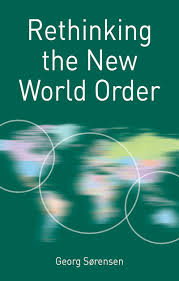In Rethinking the New World Order, Georg Sørensen explores timely questions regarding the nature of the ‘old’ and ‘new’ world order in the light of recent global uncertainty and widespread state fragility. Mehmet Kerem Coban welcomes Sørensen’s attempt to present a middle ground between realist and liberal approaches to IR, while calling for even greater theoretical pluralism when it comes to understanding the current state of the world order.
This book review has been translated into Mandarin by Ines Söderström (Mandarin LN340, teacher Lijing Shi) as part of the LSE Reviews in Translation project, a collaboration between LSE Language Centre and LSE Review of Books. Please scroll down to read this translation or click here.
Rethinking the New World Order. Georg Sørensen. Palgrave Macmillan. 2016.
 We are entering a new phase of globalisation. The future of the liberal world order established by the transatlantic powers has become more debatable. The presidential elections in the United States, the so-called ‘Brexit’ referendum, current and upcoming elections in continental Europe and the emergence of nationalist rhetoric are all leading us to ask significant questions about liberal politics across the world. In light of this uncertainty, Georg Sørensen’s book’s great achievement is posing timely and difficult questions about the ‘old’ and ‘new’ world order.
We are entering a new phase of globalisation. The future of the liberal world order established by the transatlantic powers has become more debatable. The presidential elections in the United States, the so-called ‘Brexit’ referendum, current and upcoming elections in continental Europe and the emergence of nationalist rhetoric are all leading us to ask significant questions about liberal politics across the world. In light of this uncertainty, Georg Sørensen’s book’s great achievement is posing timely and difficult questions about the ‘old’ and ‘new’ world order.
To begin this review, it is useful to be clear with the meaning of ‘world order’. Sørensen defines this not just as relations between states, but also as a reflection of what is happening within states (31). In Rethinking the New World Order, Sørensen provides a new analytical framework consisted of three pillars: domestic conditions, international conditions and the global distribution of power. Hence, this framework calls our attention to a more complicated analysis of ‘world order’, which aims to bring the domestic and international together with an understanding of global power distribution.
In the first chapter, Sørensen presents the book’s analytical framework, while reviewing the main theoretical traditions in international relations theory. The second chapter discusses how all states, regardless of income, economic and political development, are fragile. The sources of ‘state fragility’ change if one travels from an advanced economy to a postcolonial state. However, one commonality regarding ‘state fragility’ is that all states have to cope with social and economic uncertainties that are causing rising income inequality, declining trust in societies and persistent intra-state conflicts. The third chapter demonstrates that interstate war is no longer the top threat to world order as the political, social, and economic costs of such conflicts have risen tremendously in an interdependent world.
In the fourth chapter, Sørensen argues that power neither guarantees the formation nor the subsequent maintenance of a particular kind of world order. A powerful nation should also possess the capacity – and, probably more importantly, the will – to lead that order. For Sørensen, we can expect different types of world order. The first is Amitav Acharya’s (2010) ‘multiplex’ order, referring to a ‘world order’ that is neither unipolar nor multipolar but rather involves multiple stakeholders and alliances, and is politically and culturally pluralistic. The second is a heavily regionalised order.
 Image Credit: (Sam Howzlt CC BY 2.0)
Image Credit: (Sam Howzlt CC BY 2.0)
The fifth chapter discusses intervention in fragile or conflict-ridden states, order and legitimacy. Sørensen puts forward the argument that interventions in fragile states may involve both peace-keeping and state-building. Furthermore, the legitimacy of the Western-led order has declined in recent years. The formation of the ‘new world order’ can be challenging because it requires the crafting of an order that is perceived as legitimate. With more stakeholders in world politics claiming greater space, this will not be an easy task as there may be too much ‘noise’ when moving from one order to another. This means that until the ‘new order’ is fully established, we may expect to observe ‘regional security complexes’ as ‘second-best institutions’ (123).
The sixth chapter claims that conceiving ‘convergence’ between advanced nations and developing nations can be a ‘rosy picture’. Globalisation has contributed to a world that is marked by both extreme wealth and poverty. Sørensen highlights that the current order operates according to the logic of the neoliberal economic model. He questions if this can contribute to stability, especially when expectations of improved economic conditions are forcing developing countries to seek higher growth rates. Furthermore, while advanced nations are struggling with sluggish growth and maintaining their advantage in the international trading system, some developing nations are getting more and more competitive in similar international markets.
In the eighth chapter, Sørensen maintains that today’s liberal order has been shaken by internal conflict driven by clashes between independence and interdependence. The liberal world order has been established on the basis of interdependence. However, the recent backlash around the world signifies that independence is emerging on individual and national agendas (205). What this trend will bring about cannot be predicted; however, Sørensen draws attention to the constant clash between the two, which may produce some unpleasant consequences such as the rise of populist right-wing political parties.
Sørensen nonetheless underlines that despite many challenges, global governance may not be experiencing a ‘gridlock’. The way we are currently making attempts to resolve our global problems may not lift living standards upwards, for instance, in the case of enforcement of climate change agreements; however, we can cut carbon emissions and slow global warming. ‘Good-enough governance’, for Sørensen, therefore means we can still address our common challenges, albeit often through second-best arrangements.
The above paragraphs give a glimpse into Sørensen’s book by presenting the main debates. Although its title refers to the ‘new world order’, the main mission of Sørensen is not limited to what this means or how we can make sense of it. Rather, the book speaks to a larger theoretical debate, which is the realist and liberal divide in international relations theory.
Throughout the text, the reader is always reminded of this grand debate. Yet, instead of attempting to assess which theoretical account prevails over the other in an analysis of the ‘new world order’, the book presents a middle ground. Sørensen argues that realists should put aside the dominant thinking about the world order, based around the assumption of security dilemmas, persistent conflict and inter-state competition that always results in warfare. Liberals, on the other hand, should not expect a linear trend of modernisation or assume that their way of thinking is the only model applicable in any jurisdiction.
Sørensen therefore opts for a balanced view in calling for theoretical pluralism in international relations theory. Such an approach necessitates us to deeply engage with ‘reality’, and therefore tailor our analyses. This would, for instance, require a realist not to begin an analysis with the expectation that conflicts are persistent. Co-existence may not be peaceful, yet wars are not inevitable, particularly in today’s world order which is defined by greater interdependence not only in terms of economic exchange, but more importantly through political and social interactions between societies.
To end this review with a suggestion for future research, other theoretical traditions in international relations theory deserve equal treatment as part of our theoretical toolkit. Focusing solely on the divide between ‘optimist liberals’ and ‘pessimist realists’, as Sørensen terms them, can be somewhat reductionist. We need to incorporate other traditions into the debate. This is because we should not underestimate how individuals gather data, learn how to process it and act according to what is produced. The ‘social construction of reality’, as Peter L. Berger and Thomas Luckmann put forward decades ago, refers to ideas being diffused across individuals and societies. How we perceive the world around us and how this shapes our expectations about the future are as significant as the distribution of power and the linkages between domestic and international forces. Therefore, a more constructivist account of the ‘new world order’ could be very valuable to make sense of the meanings of various forces leading this, how these meanings are perceived particularly by policymakers and how these in turn affect the ‘new world order’ that shapes our economic, social, cultural and political interactions across societies.
Mehmet Kerem Coban is a PhD Candidate at the Lee Kuan Yew School of Public Policy, National University of Singapore. His PhD thesis focuses on the political economy of banking regulation in Turkey (financial consumer protection, macroprudential regulatory governance and the adoption of Basel III). He obtained his Master’s Degree in Development Studies at the Graduate Institute of International and Development Studies, Geneva. His main research interests are international political economy, the political economy of development, regulation, financial liberalization and financial regulation. Email: m.keremcoban[at]u.nus.edu. Read more by Mehmet Kerem Coban.
Note: This review gives the views of the author, and not the position of the LSE Review of Books blog, or of the London School of Economics.
在近些年来世界不确定性与国家脆弱性的情况下,Georg Sorensen的新书《重新思考国际新秩序》探讨“旧”和“新”国际秩序性质的一些问题。Mehmet Kerem Coban 欢迎Sørensen建议的国际关系理论现实主义和自由主义之间的中间地带,不过同时为了充分地理解新秩序,他也呼吁更理论更多元化。
Review translated by Ines Söderström (Mandarin LN340, teacher Lijing Shi)
 我们正在进入全球化的一个新的阶段。跨大西洋国家建立的自由国际秩序的未来变得更具争议性。 美国的总统选举,脱欧全民公决,欧陆国家将来的选举,以及民族主义言论的出现,都使我们对世界各地的自由主义政治提出了重大问题。在此不确定的情况下,Georg Sørensen的新书及时地探讨了关于”旧” 和”新” 国际秩序中的疑难问题。
我们正在进入全球化的一个新的阶段。跨大西洋国家建立的自由国际秩序的未来变得更具争议性。 美国的总统选举,脱欧全民公决,欧陆国家将来的选举,以及民族主义言论的出现,都使我们对世界各地的自由主义政治提出了重大问题。在此不确定的情况下,Georg Sørensen的新书及时地探讨了关于”旧” 和”新” 国际秩序中的疑难问题。
首先,理解”国际秩序”的概念十分重要。Sørensen对”国际秩序” 的定义不仅是邦国间的互相关系,也反映了在这些国家的内务。在这本书,作者提供一个新的分析架构,其包括:国内形势,国外形势,和全球势力分配三个方面。由此,这一构架引起大家的关注,从而去寻求更全面地分析研究国际秩序。此是为了旨在了解全球势力分配的基础上结合国内和国际因素。
在第一章中,作者发现了该书的分析框架,同时回顾了国际关系理论中的主要理论传统。第二章讨论了所有国家都是脆弱的,不管收入、经济和政治发展如何。例如,从发达国家到后殖民的国家,可以观察到“国家脆弱性”的来源不同。然而,关于“国家脆弱性“ 的一个共同点是:所有国家都必须应对社会和经济带来的不稳定性,这些不稳定性导致收入不平等加剧、社会信任度下降和国内冲突持续存在的不确定性。第三章展现出州际战争不再是对世界秩序的最大威胁, 这是因为世界变得越来越相互依赖,而这种战争的政治,社会和经济成本都极大上升了。
在第四章中,Sørensen争论了“实力“ 即不能保证也不能维持一种特定的国际秩序。一个强大的国家应该拥有领导这一秩序的能力。也许更重要的是,拥有领导这一秩序的意志。根据作者的论点,我们应该期待有不同类型的世界秩序存在。第一类,是Amitav Acharya (2010) 提议的”多元化国际“,指的是既不是单极也不是多极的“世界秩序”,而是涉及多个利益相关者和同盟者,它在政治和文化上是多元化的。第二类是一个高度区域化的秩序。
 Image Credit: (Sam Howzlt CC BY 2.0)
Image Credit: (Sam Howzlt CC BY 2.0)
第五章讨论在脆弱或冲突的国家干预,秩序,与合法性。Sørensen提出的论点是对脆弱国家的干预包括维持和平与国家建设。再则,近些年来西方国家领导的国际秩序合法性愈来愈低。“新国际秩序”的形成可能具有挑战性,因为它需要制定一种被认为是合法的秩序。随着世界政治中更多的利益相关者声称拥有更大的空间,这将不是一项容易的任务。这是因为从一个秩序转移到另一个秩序时可能会有太多的“噪音”。 这意味着直到“新秩序”完全建立之前,我们可能会将“区域安全综合体”视为“第二最佳机构”。
第六章声称,发达国家与发展中国家之间的“融合” 可能是一个太“乐观的画面“。全球化加剧了世界上已经存在的极端财富不平等。Sørensen 强调,当前的秩序是按照新自由主义经济模式的逻辑运作的。他认为,不断增长的经济体的期望迫使发展中国家寻求更高的增长率,这可能会危及稳定。另外,发达国家正在努力应对经济增长缓慢, 并在国际贸易体系中保持优势。同时,一些发展中国家在类似的国际市场上的越来越有竞争力。
在第八章中,Sørensen认为,由于独立和相互依存之间造成的内部冲突,今天的自由秩序已经动摇了。当前的自由国际秩序是建立在相互依存的基础上的。不过,世界各地最近的强烈反对表明,独立正出现在个人和国家的议程上。这一趋势将带来什么是无法预测的,但是,作者提请人们注意相互依存和独立之间的持续斗争,因为这种现象可能会产生一些不愉快的后果,如民粹主义右翼政党的崛起。
尽管面临许多挑战,Sørensen认为,全球治理可能并未出现“僵局”。目前试图解决全球问题的方式可能不会提高生活水平,例如,在执行气候变化协议的情况下。可是,我们仍然可以减少碳排放,减缓全球变暖。对Sørensen 来说,“足够好的治理““意味着我们仍然可以解决共同的挑战,尽管通常在方案上”退而求其次“。
以上段落展现 Sørensen主要的辩论,让我们大致对他的书有一些了解。虽然书名谈到了“新的世界秩序”,但这本书的目标并不局限于它的意思是什么,以及我们如何理解它。相反,这本书其实讲述了一个更大的理论争议,也就是,现实主义和自由主义在国际关系理论上的二分法。
在整个文本中,读者总回想起这场大辩论。然而,在对“新国际秩序”的分析中,这本书并没有试图评估哪种理论解释优于另一种,而是提出了一个中间立场。Sørensen认为,现实主义者应该抛开关于国际秩序的主导思想,亦即,基于安全困境、持续的冲突和总是导致战争的国家间竞争的假设。另一方面,自由主义者不应期望现代化的线性趋势,也不应假定他们的思维方式是任何司法管辖区唯一适用的模式。
因此,Sørensen选择了一种平衡的观点:他呼吁国际关系理论的多元化。这种方法需要我们深入地接触“现实”,从而调整我们的分析。例如,这就要求现实主义者不要以冲突一贯存在的期望开始分析。共存可能不是和平的,但战争并非不可避免的,特别是在当今的国际秩序中,这一秩序的特点是更大的相互依存,不仅是在经济交流方面,更重要的是通过社会间的政治和社会互动。
让我以对未来研究的建议来结束这篇评价,国际关系理论中的其他理论传统也应作为我们的理论工具包的一部分并受到同等对待。仅仅关注“乐观的自由主义者”和“悲观的现实主义者”之间的鸿沟,正如Sørensen所说,可说是过度简化。我们需要把其他传统纳入这一辩论。这是因为我们不应该低估个人如何收集数据,学会如何处理数据,并根据产生的数据采取行动。正如Peter L. Berger和Thomas Luckmann几十年前提出的那样,“现实的社会建构”是指思想在个人和社会中传播。我们的世界观和我们的世界观又如何影响/塑造了我们对未来的看法,跟国际国内间的权力分配和联结同样重要。。因此,一个对“新国际秩序”更具建设性的解释,应当深刻理解导致 “新秩序“ 的各种力量、尤其是政策制定者是如何理解它们的。 这些又如何反过来塑造不同社会里的经济、社会、文化和政治的互动。







